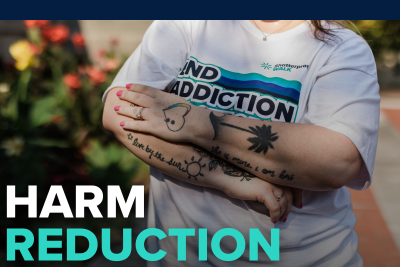
Living in Recovery
2024 Shatterproof Addiction Stigma Index Key Findings
To illustrate the real-world impact of stigma, the 2024 SASI results are illustrated through the lens of Kaitlyn and her journey with substance use.

Kaitlyn was in active addiction for 10 years.
During this period of her life, she went to multiple treatment centers, attended withdrawal management programs (also known as detox) countless times, and experienced incarceration.
Similar to other chronic medical conditions, SUD does not have a one-size-fits-all treatment. Like many, Kaitlyn’s pathway to managing her SUD was not linear and took sustained commitment.
Both Kaitlyn and her mother, Angela, remember that Kaitlyn’s competency and trustworthiness were constantly called into question, with family members hiding their purses when she attended family gatherings and Kaitlyn not being allowed to work the cash register at her job.
She also lost custody of and contact with her children over an eight-year period, despite knowing that all she had to do was stop using substances to see her kids.
“I didn’t know how to walk away.”
Like many people navigating substance use, Kaitlyn’s journey intersected with the carceral system.
After a judge court-mandated Kaitlyn to a treatment program, she recalls how she prematurely left the program and had a recurrence of use:
“It got worse for me in those 30 days than it had ever been. I was going to use, and driving down the road and just crying, and all I could tell myself was, ‘I don’t want to do it anymore.’”
In this pivotal moment, Kaitlyn decided to go to court and plead her case before the judge.
It was the first time she admitted to somebody that she needed help, and the judge decided to send her back to treatment.
That decision is widely supported, with 79% of adults believing that people with SUD should receive treatment instead of prison. It was an extension of compassion that ultimately enabled Kaitlyn to maintain recovery.

Restoring hope with compassion.
Today, Kaitlyn is married to her wife Cynthia, who is also in recovery. Together, they parent their son, who is back in Kaitlyn’s custody. As a family, they love to slow down and they don’t take this time together for granted.
In Kaitlyn’s professional life, she has channeled her experiences into a higher purpose as a peer recovery specialist: “I want somebody to be able to look at me and believe me when I say, ‘I know how you feel. I’ve been there.’”
Kaitlyn's journey illustrates that not only is SUD a treatable medical condition, but that there are many different pathways to recovery.
She’s living proof that we can create a world where health and well-being are within reach for those navigating complex medical conditions.





